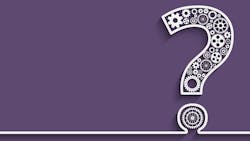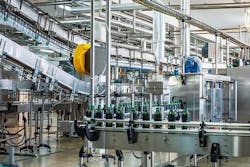20 critical questions you should ask to optimize the reliability and maintainability of new equipment
One of the biggest challenges I faced as a manufacturing plant reliability engineer (RE) was managing new equipment that had been installed in my area of responsibility without my knowledge or input. Several of those assets jumped to the top of my list of bad actors.
Experience has taught me to get involved with new equipment as early as possible with a cradle-to-grave mentality. This article lists 20 questions that every RE should ask to optimize the reliability and maintainability of new equipment, and prevent the negative consequences of late engagement: chronic reliability problems, high cost, and short useful life. (Safety and environmental concerns are of the utmost importance, and need to be addressed by experts in those fields.)
1. Have the equipment specifications been provided to the vendor yet?
The earlier you, the RE, get involved the more you can impact the design and total cost of ownership. By getting involved early in the project you’ll have the opportunity to work with design engineering, providing requirements and special conditions that will affect the operation and maintenance of new equipment.
If the equipment has already been purchased, the inherent reliability is fixed but you can still impact the operational reliability and life cycle costs.
2. What is the criticality of the new asset?
Rank the criticality of the new asset with respect to the rest of the plant. Equipment criticality is a ranking reflecting the magnitude of the consequences resulting from an equipment failure.
The most critical assets impose the greatest risk to the value stream and a risk-based asset management plan is recommended utilizing failure mode and effects analysis (FMEA). The FMEA for critical assets can be leveraged to similar equipment of a medium-high criticality. Medium-criticality assets should utilize original equipment manufacturer (OEM) recommended maintenance and operating plans.
3. What are the functional requirements of the new equipment?
Define the active and passive functions, including performance standards, which the equipment must demonstrate throughout its lifecycle. This involves understanding all aspects of how and in what circumstances the asset is going to be operated, maintained, and ultimately taken out of service. Create a functional block diagram and define what constitutes functional failure.
4. What are the reliability requirements?
Document the required reliability that the equipment or system must be designed to achieve. The essential elements of a reliability specification are:
- Quantitative statement of the reliability requirement
- Description of the environment in which the equipment/system will operate
- Time measure or mission profile
5. What is the life expectancy of the new equipment?
Life expectancy is not only a critical design parameter, it also impacts the total-cost-of-ownership calculations. Therefore, a realistic evaluation is important to achieve the project needs and secure return on investment.
6. What are likely failure modes for the asset type?
Review equipment history in the computerized maintenance management system (CMMS) for similar equipment in your facility or business. Look for dominant failure modes. Environmental conditions may intensify the mechanisms causing those failure modes, requiring additional service factors in the equipment specifications.
Michael Blanchard is a Reliability Engineering Subject Matter Expert with Life Cycle Engineering. Michael is a licensed Professional Engineer, a Certified Reliability Engineer, and a Certified Lean-Six Sigma Master Black Belt. A leader dedicated to helping teams achieve their goals, Michael maintains a strong focus on sustaining gains and delivering value. Contact him at [email protected].
If you get involved early enough, you can cost-effectively address high-risk failure modes with design changes. A design FMEA is the recommended tool for organizing failure data and ranking risk in the design phases. If the equipment is already purchased, those failure modes are typically mitigated with predictive and preventive maintenance. In this case, a reliability-centered maintenance FMEA is recommended.
7. Is the asset designed with maintainability in mind?
If you get involved early enough, aim to adhere to these five principles:
- Standardized components. Standardization reduces the chances of using the wrong parts when corrective maintenance is performed, and results in fewer parts to deal with in inventory. It also reduces training and skill requirements, and often drives down design costs.
- Interchangeable parts. Different components can often be installed as replacement parts with no special customization required. This reduces maintenance and operational inventory, cost, and chance of using an incorrect part.
- Modular design. This design concept divides the installation into individual sections or units for quick replacement. This allows for easy isolation, removal and replacement of those modules with minimum downtime.
- Accessibility. Maintenance craft should be able to gain easy and safe access to parts that need maintenance.
- Software monitoring controls. When monitoring is done manually it can result in inconsistency, omission, or error. Software controls allow for continuous monitoring and thereby timely and accurate completion of tasks that ensure asset reliability.
8. What are the estimated lifecycle costs?
If you get involved early enough, total cost of ownership estimates can be used to compare design options in order to select components (or entire systems) that have the lowest lifecycle costs. As the RE you will need estimates for design, purchase, installation, operation, maintenance, and ultimately disposal of the asset. You will also require applicable tax and discount rates. Lean on the accounting function for support.
9. What is the experience and reputation of the equipment manufacturer/supplier?
Examine the potential of sourcing equipment from preferred partners. These manufacturers/suppliers have gained favor through positive experiences. This functional partnership is essential to high reliability and optimized total cost of ownership.
10. Is the application of this technology well understood?
Risks can be underestimated when new technology is introduced to plants with little or no experience. You may have to visit an installation where the asset is currently operating.
Discuss issues with people operating and maintaining the equipment and incorporate what you learn into the maintenance and operation plans. Operators and maintenance craft will likely require training to ensure reliable operation.
11. What are the factory acceptance testing (FAT) requirements?
Develop the FAT to include appropriate general testing procedures for verifying the predefined performance standards and correct operation of the equipment. These tests are normally executed during the final part of the design and engineering phase, and before the final installation at the plant.
12. What are the commissioning requirements?
You as the RE will be responsible for identifying those criteria that verify equipment is installed according to the manufacturer’s recommendations and to industry-accepted minimum standards. Commissioning will verify and document specified performance of equipment and systems. You should establish baseline predictive maintenance (PdM) readings during the verification process.
13. How will the equipment be operated?
Provide instructions on how to operate assets within appropriate design, maintenance, and operational parameters to achieve business objectives. Standard operating procedures (SOPs) should be written and incorporated into operating discipline. You should complete this prior to start-up.
14. How will the asset be maintained?
Explain how the organization will determine and manage maintenance activities to meet the asset management objectives. Recommended PM/PdM tasks from the FMEA or OEM should be incorporated into the CMMS prior to turning the asset over to operations, including all job plans and repair procedures.
15. What are the training requirements?
The operators and maintenance craft may need additional training. This is especially true if the technology is new or not well understood. Perform a gap analysis of existing and required skills and build a training plan. All training gaps need to be completed prior to start-up.
16. What information is needed to set up the new equipment in your CMMS?
Gather the information needed to properly register the asset in the CMMS. This will typically include establishing the functional hierarchy structure and adding the asset master data. The documentation will include operation and maintenance manual, drawings, equipment attributes, specifications, and bill of material (BOM) data.
The PM/PdM tasks should be input to the CMMS prior to commissioning. You will likely be providing this information to your plant’s CMMS expert.
17. Will the asset use smart PdM devices?
The IoT is now used extensively to support asset health. If you get involved early enough in the project, smart devices can be included in the design package. If the equipment is already purchased, consider retrofitting the design with smart PdM devices. You can partner with an IoT service provider to set up, access and analyze data from sensors and devices, and convert them into actionable instruction.
18. What are the spare parts requirements?
You as the RE will be responsible for identifying any critical spare parts and defining spare parts quantities. The criticality of parts is primarily based on their impact on production process or employee safety if they fail, and on the lead-time for ordering. High-criticality parts need to be held on site as insurance spares. For low-criticality parts, start with recommended OEM parts and stocking levels. Partner with materials management to optimize quantities.
19. What are the plans for continuous improvement?
Establish a process to evaluate whether or not the new asset is meeting the project reliability requirements and define appropriate action to close performance gaps. Trend these metrics and use root cause analysis if the performance doesn’t meet requirements or deteriorates over time.
20. Is there a plan for decommissioning and disposal?
Describe the processes involved to decommission and dispose of assets due to aging or changes in performance and capacity requirements. Considerations for these processes include:
- Environmental impact of disposal
- Land rehabilitation
- Residual value of assets
- Continued service delivery
- Human resource plans
As a reliability engineer you already have enough to do without adding bad actors to your workload as a result of poor planning and misuse of resources. Ask these 20 questions to ensure high reliability, minimum costs, and long equipment life.

